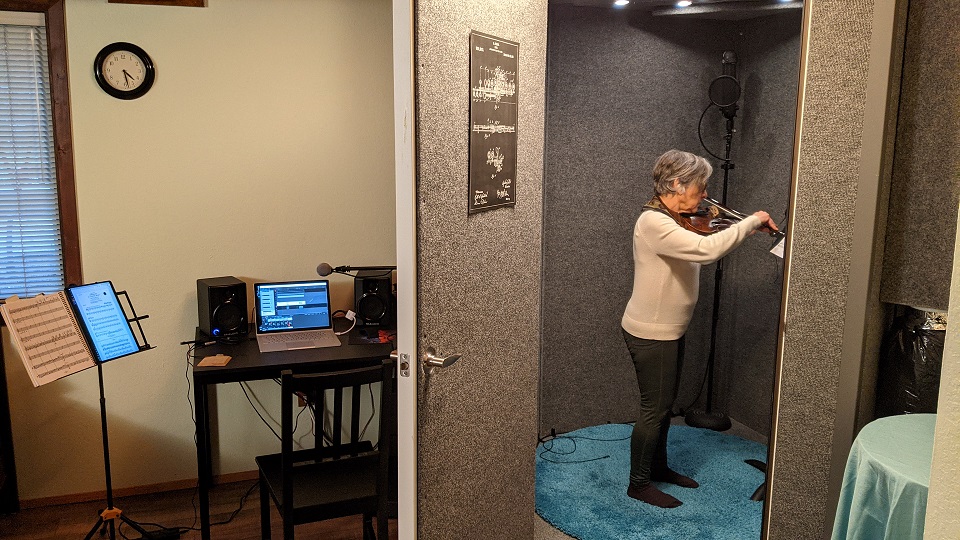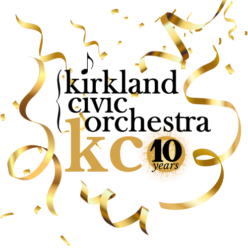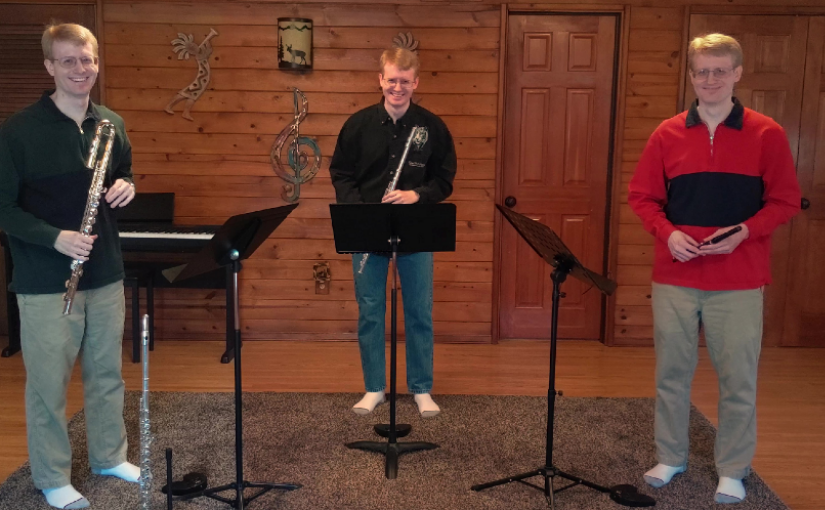Our first interview with one of the virtual concert creators is with Doug Gallatin. He plays with the KCO but also directs the River Wind Flute Choir.
- Who are you and what do you play in the KCO?
- What started you down the musical road and where was this?
- How did you end up in the orchestra?
- How did you get into the virtual projects? How do you do it?
- How much of editing of the parts do you have to do?
- What is something that you didn’t expect with this type of project?
KCO – Who are you and what do you play in the KCO?
Doug: I’m Doug Gallatin – the piccolo and flute player at Kirkland Civic Orchestra and in a number of other orchestras and groups around here. I’ve been playing flute since fifth grade, which is a while ago at this point.
I enjoy playing flutes of all shapes and sizes. I play bass flute, alto flute, c flute, piccolo, recorders, bamboo flutes, and such in various groups. All these flutes and have become a wonderful hobby for me.
KCO – I’ve seen some of the flute choir videos.
Doug: I direct the River Winds flute choir. We’ve been doing YouTube videos in place of concerts there as well. We get flutes all the way down, well, not quite to the tuba level. We have all the way down to the contrabass flute, which is bigger than me. It is this huge, huge thing and the players when they bring it in and set up, they take up a whole corner of the room–just between the stand and the flute and everything. It fills out the sound and gives you that lower end that you don’t really think of when you think of a flute player.
KCO: What started you down the musical road and where was this?
Doug: I started in elementary school band, and then did band basically throughout school, taking private lessons on and off.
This was in California, at the tail end of removing music from all the school programs. There was an assembly when I was in first grade where the music teacher was demonstrating all the instruments. She played the flute and I decided that was what I was going to do.
I decided that’s the one and it didn’t matter about some of the sex differences between instruments and some of the stereotypes. I just, nope, I don’t care. I’m playing flute. Sign me up for flute, Mom.

Within the instruments, flute is over-represented on the west coast. I don’t think it’s true on the East Coast so much, but in California and Washington, there are 20 flute players for every one of anything else.
I remember in band and junior high, there were maybe 30 flute players in the band and the middle school band was 50 or so. We were three rows of the band, all the way across the band room. You have the chairs and the positions and stuff, but they were always trying to get you to play something else, “look at this pretty bassoon. Look at this other instrument.”
In 6th grade, I got told you should just quit by the band teacher. “You’re not cut out for this.” That provided the motivation due to the competitiveness inside me. Now I’m going to keep doing this. I’m going to be the best in the class. I took that as a challenge and through junior high, high school, I improved greatly. I got to the point where I was thinking about pursuing a music career. I was doing all the honor bands, and getting towards the top of the section, if not the top of section.
National Honor Band was kind of a defining moment of that. I got to play with Mason Bates. He’s a composer and he does a lot of electronic techno with orchestra. I had gone to see the San Francisco Symphony playing, with him premiering one of his pieces. I forget which, but he had a broom, just a big guy with a broom sweeping in the back of the percussion. This guy with the tux and the bow tie and he was just going crazy sweeping. I’ll always have that picture in my head whenever someone says they play percussion.
KCO: Why wouldn’t you? That’s awesome.
Doug: That was a really cool concert to go to and then I got to play with him and this honor band, where we played a piece based on the sounds and things that you hear in North Carolina. It was a, I don’t know, a 20-minute piece that was broken up into all sorts of sections and some of them had electronic backing. Things that we played along with some of them had all the sound effects going, some of them had all sorts of crazy extended techniques for flute. Some of them were really challenging. It was a really great experience.
And then marching band. I ended up being the soloist in the senior marching band, section leader, doing all those fun sort of things.
In college, I decided I was going to go pursue music but had the thought maybe I should do something else to pay for your music and such. I really like programming and computer science. So, I ended up getting my bachelors in computer engineering with a math minor and a masters in computer science.
I joked that as an engineering major, I spent 90% of my time in the music building. I didn’t spend as much time in the engineering classrooms or on the projects. I started a woodwind quintet. I started a flute choir. I was playing principal in their orchestra. I was playing piccolo in their band. I was doing all the solo things that they would let me do. They had quarterly solo recitals that were mostly all the music majors, but I was also the guy that was playing in them. Playing with the Bach Ensemble, playing with the choirs for the Christmas concert.
KCO: And where was this?
Doug: I went to Cal Poly, in San Luis Obispo, and was there for five years or so. I quite enjoyed that and that’s where I learned how to play with small groups, how to conduct, and how to direct an ensemble. I just played continually.
KCO – How did you end up in this orchestra?
Doug: Then from there, I moved up here to Kirkland, working at Microsoft. That was when it was the Microsoft Symphony. When I was up here for my internship, I went to one of the concerts at the Ballard Locks. I just enjoyed it. It was really cool. I think it was it was the one of the ones where it was raining and it just struck me that only in Seattle, would you guys be playing outside while it was raining.
And everyone was huddled under these little, tiny tents and all the brass were out. I was thinking these people in Seattle are crazy. They play out in the rain. We wouldn’t even consider this in California.
KCO: That’s the one time, but that’s a great story.
Yes, I moved up here working for Microsoft. I just said yes to everybody before the pandemic hit. I think I had seven or eight rehearsals a week. It was work and then rehearsal, and then get home like 10/11 at night and do it all again.
Then I started directing the flute choir, The River Winds flute choir, which grew out of the River Winds band that I got invited to play one summer and then came back. They had a flute choir that was running kind of on and off and I ended up starting, directing, and organizing it. It just grew into this standalone wind ensemble effectively now, where we have 16 to 20 flute players before the pandemic hit.
We would go and play in one concert a quarter. We have our Winter concert and then a Christmas concert and then a concert in the winter and spring where we play about an hour or the music: some hard things, some easy things, for retirement homes. We just have a great time, for the most part.
KCO: So how did you get into the virtual projects? How do you do it?
Doug: It’s part of my music experience. I’ve been mixing live for theaters and churches and that sort of thing, doing the sound engineering since about eighth grade. Running just the sound side of it. Doing set-up, operating the soundboards, dealing with the effects and mix, dealing with all that stuff. Before the pandemic, I had acquired some microphones and equipment such that I could record, small groups, like woodwind quintets, and would regularly record the flute choir performances.
Whenever the flute choir would perform, I’d bring my mic setup and the big boom stand and record the audio for us to listen to later, for improvements or for CDs. It’s great. The audio side, I had already kind of as an amateur, gotten used to the audio software.
Also, when I was in an apartment, I acquired a recording booth because I needed it to practice the Shostakovich piccolo part. Playing piccolo part in an apartment when you’re working until 7 p.m. is not a good recipe for not getting evicted. It’s part of being in the apartment. The booth has seven-inch walls, and it provides a 110 DB or so of sound isolation.

Since I moved out of the apartment into a house, I hadn’t set it up. I set it up for the pandemic and so that means that I put a microphone inside. It’s got its own ventilation system than can connect to a window and then people would come one at a time to go into the booth, record their parts and then rerecord the video, either outdoors or in a room or somewhere separately because it’s just a box. It’s not particularly interesting background.
That’s how that started on the audio side. I quickly realized we need video to go along with it. I knew nothing about video. I was using my phone to record the first ones. Since then, I’ve acquired a little bit more equipment. A real DSLR camera. I can do full 4K.
Recently, I’ve been doing green screen things, because in the winter season, the house, the backgrounds get old.
KCO: Some of the musicians in the orchestra, they have no idea how to record. It was great that you offered that.
It’s a funny thing because the actual technical side of it, you don’t have to know any of that. For Sleigh Ride, I imported the click track in my software and so we could go over phrases, or I could say, let’s start at A and start playing from A. And then let’s get three takes of A and then, let’s okay, let’s go to C. You missed a note here there, and we can jump to C and do that.
I can stitch it together in my software. Make it line up with the click track automatically and they don’t have to worry about that.
Now it’s used for recording, and when people come one at a time to record their part. It helps to have me there because I’m listening to them and watching them. At the same time, I’m critiquing, Master-classing, suggesting things depending on the player and the level and how comfortable they are. I can guide them and say, “hey, this this part was really rough. You want to try that again?”
I say it should be a performance level quality. Not necessarily perfect. It’s kind of like a mini rehearsal session with them. We can discuss if they are emphasizing this too much or that too little. For the flute choir, I’m sitting there for each person and so for any interpretation things, I can make sure we’re kind of on the same page as a group.
I can listen for missed notes, or if notes are out of tune. I have their part in front of me and they have their part in the booth and we can do it as many times as they want, within reason. It’s taken, for every minute, maybe 15 minutes of recording in my experience.
For Sleigh Ride, it was taking maybe 30 minutes to record the audio, and that includes some set up time from when they walk in the door. We record the audio 30 minutes, and then spend another 10 minutes to record the video.
KCO: Let me say as a member of the orchestra, thank you for doing that because it was it really helped out. And I’m sure people learned a lot.
Doug: Thank you. Yes, the benefit of doing it this way, is that the people that come, they don’t need any technical experience. They don’t need to know anything: the mic is set up, everything is set up for them. I’ll stitch it all together for them. I’ll deal with all the uploading, putting the video with the audio, which is another big benefit of doing it the way that I’ve been doing it. The video is separate, not recorded at the same time as the audio. When necessary, you can do the audio takes multiple times for that one hard part.
KCO: In the software, you combine multiple tracks into one performance. How much of editing of the parts do you have to do?
Doug: It depends on the player. Some people come in and they play it once through and it sounds great. We get a second take just in case I miss anything because I don’t want to call anyone back. For some people, we’ll do that and then, there will be one or two hard measures that we go over a couple times.
I can, more-or-less cut between takes on a note-by-note basis. Legato gets little bit iffy sometimes but certainly anything where there’s any rest or space, staccato note or just standard marcato, anything like that, I can cut on a note-by-note basis.
One thing I did do with the Kirkland project was to fix some of the upbeats. Upbeats are really hard to do when you have nothing to go with or just midi. When you’re playing upbeats or syncopated things. Everybody does them slightly differently. And so, if they’re too scattered it starts sounding weird. It’s easy just to say, “oh, this one needs to move here. And this one’s off there,” as I’m listening through the take. Later, I can adjust them.
KCO: What is something that you didn’t expect with this type of project?
Doug: It’s weird with the recording, because you know, no individual player hears or gets any sense of the music we’re playing, right? It’s more of an individual practice, thing. A lot of the music is in the edit by setting the relative volume levels, bringing out this part, bring down that part. Finally, it sounds like you’re all playing together after adding some reverb and delay effects and stuff like that. And then you’re fixing all the rhythm and the pitch to whatever extent that you feel is necessary. I tend to do very little for the slow movements and a lot more for the fast movements. Finally, that’s where the music is made, and it’s weird because it’s like 50 hours later.
Finally, here’s what it’s supposed to sound like. When you’re listening to all the parts individually, it’s very much not “music” at that point. It’s missing something. And there’s always that point in the project where it’s like, “oh this is what it’s supposed to sound like.”
It’s always a good feeling to get to that point because then it’s just small tweaking after that. But before that, sometimes I’m thinking this is just never going to work. We weren’t playing together. Why did I think this piece was a good piece to try to record?
KCO: Well, I want to say thanks, thanks for taking the time to do all that. I’m glad we got a chance to talk.
Thanks to Doug for the interview on 11 May 2021.
by Francis X. Langlois – tuba player in the KCO

